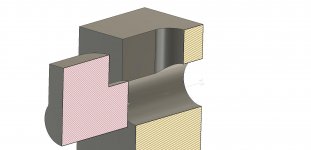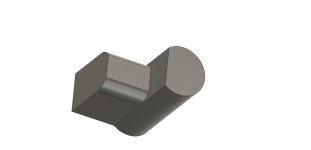I have a part that I am trying to figure out how to machine that has an intersecting radius and diameter perpendicular to each other. Radii? Cylinder? Look at the picture and it'll make sense.
I initially looked at casting the parts, because they are small, and to me it is a great part to cast, but all the quotes I got back were $6-$8k for tooling. I doubt I could amortize the cost of the tooling over the life of the product, the volume just isn't there (guessing... I haven't made them or sold them yet). I don't have a background in foundry work, and none of the shops I talked to, even a small local shop was interested in letting me machine the molds to their specifications.
So I'm back to making at least the first batch of 50-100 pieces machined. I sent the part out to a couple/few shops and after 3-4 months didn't get a quote from anyone.
For reference the example I made up the vertical cylinder is .125 diameter and the horizontal radius is .05". There's more to the part but the rest of it is straightforward.
I've got a few ideas how to pull this off but none of them are good or cost effective. There's quite a few guys here smarter than me, so I'm hoping one of you will have a bright idea on how to accomplish this.
This will be machined on a Brother 3 axis machine and programmed on Fusion. Fusion of course being the biggest limitation......
I initially looked at casting the parts, because they are small, and to me it is a great part to cast, but all the quotes I got back were $6-$8k for tooling. I doubt I could amortize the cost of the tooling over the life of the product, the volume just isn't there (guessing... I haven't made them or sold them yet). I don't have a background in foundry work, and none of the shops I talked to, even a small local shop was interested in letting me machine the molds to their specifications.
So I'm back to making at least the first batch of 50-100 pieces machined. I sent the part out to a couple/few shops and after 3-4 months didn't get a quote from anyone.

For reference the example I made up the vertical cylinder is .125 diameter and the horizontal radius is .05". There's more to the part but the rest of it is straightforward.
I've got a few ideas how to pull this off but none of them are good or cost effective. There's quite a few guys here smarter than me, so I'm hoping one of you will have a bright idea on how to accomplish this.
This will be machined on a Brother 3 axis machine and programmed on Fusion. Fusion of course being the biggest limitation......




